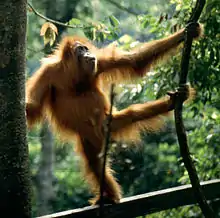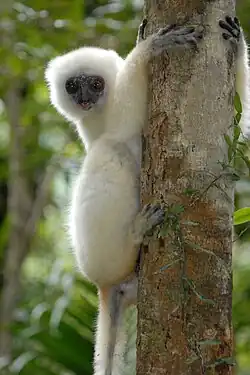The Primates Portal A primate is a member of the biological order Primates, the group that contains lemurs, the aye-aye, lorisids, galagos, tarsiers, monkeys, and apes, with the last category including great apes. With the exception of humans, who inhabit every continent on Earth, most primates live in tropical or subtropical regions of the Americas, Africa and Asia. Primates range in size from the 30-gram (1 oz) pygmy mouse lemur to the 200-kilogram (440 lb) mountain gorilla. According to fossil evidence, the primitive ancestors of primates may have existed in the late Cretaceous period around 65 mya (million years ago), and the oldest known primate is the Late Paleocene Plesiadapis, c. 55–58 mya. Molecular clock studies suggest that the primate branch may be even older, originating in the mid-Cretaceous period around 85 mya. Primates exhibit a wide range of characteristics. Some primates do not live primarily in trees, but all species possess adaptations for climbing trees. Locomotion techniques used include leaping from tree to tree, walking on two or four limbs, knuckle-walking, and swinging between branches of trees (known as brachiation). Primates are characterized by their large brains relative to other mammals. These features are most significant in monkeys and apes, and noticeably less so in lorises and lemurs. Many species are sexually dimorphic, which means males and females have different physical traits, including body mass, canine tooth size, and coloration.
Selected article
Slow lorises have been a part of the traditional beliefs of Southeast Asia for at least several hundred years. Their remains are buried under houses and roads to bring good luck, and every part of their body is used in traditional medicine to make everything from love potions to unproven cures for cancer, leprosy, epilepsy, and sexually transmitted diseases. Furthermore, a large number of slow lorises are traded as pets, both locally and internationally. Although it is illegal to import slow lorises for commercial sale, they are popular pets in Japan, the United States, and Europe, largely due to their "cute" appearance, which has been popularized in highly viewed YouTube videos. Captive lorises experience improper care and die from poor nutrition, stress, or infection. Despite this, demand has risen, and slow lorises are no longer captured opportunistically, but are now hunted on a commercial scale using flashlights, from which the animals do not flee. Connected protected areas are important for the conservation of slow lorises because these primates are not suited for traveling long distances on the ground. Training for enforcement officials helps improve identification and the awareness of their legal protection. Sanctuaries and rescue facilities are available to provide both temporary and lifelong care for confiscated slow lorises. Zoo populations of some species have not bred much recently and are growing too old to reproduce, although the pygmy slow loris is doing well at some facilities, such as the San Diego Zoo. Selected picture {{{caption}}} A Barbary macaque (Macaca sylvanus) by the Upper Rock Nature Reserve in Gibraltar. Although the species is commonly referred to as the "Barbary ape", it is in fact a monkey. The Barbary macaque population in Gibraltar is the last in the whole of the European continent. A popular belief holds that as long as Barbary macaques exist on Gibraltar, the territory will remain under British rule. CategoriesSelect [►] to view subcategories
Primates Lists of primates Primates by location Primate anatomy Primate behavior Primate conservation Evolution of primates Extinct primates Primate health Homininae Primates and humans Monkeys Primate taxa Primate stubs Selected species {{{caption}}}  Critically Endangered (IUCN 3.1)|Critically endangered The silky sifaka or silky simpona (Propithecus candidus) is a large lemur characterized by long, silky white fur and has a restricted range in northeastern Madagascar. It is one of the rarest mammals on earth, and is listed by the International Union for Conservation of Nature (IUCN) as one of the world's 25 most critically endangered primates. The silky sifaka is one of nine sifaka species (genus Propithecus), and one of four former subspecies of diademed sifaka (P. diadema). The silky sifaka has a variable social structure, and lives in groups of two to nine individuals. It spends most of its day feeding and resting, though it also devotes a considerable amount of the day to social behaviors, such as playing and grooming, as well as traveling. Females take priority over males during feeding. The diet consists primarily of leaves and seeds and is highly varied, consisting of many plant species. It is a seasonal breeder and only mates one day a year. Parental care is shared among adults in the group, as it is with other sifaka species. Like all lemurs, it relies strongly on scent for communication, often scent-marking trees near the center of its home range, as opposed to the territory borders. The species is only found within a few protected areas in the rainforests of northeastern Madagascar, with the majority of the remaining population in Marojejy National Park and Anjanaharibe-Sud Special Reserve. The silky sifaka is hunted throughout its range as there is no local taboo (fady) against eating this species. Habitat disturbance, such as slash-and-burn agriculture (tavy), illegal logging of precious woods (particularly, rosewood) and fuel-wood, also occurs within the protected areas where it is found. Did you know?
Primate lists
WikiProjectsWikiProject Science
Things to do
Associated WikimediaDiscover Wikipedia using portals
|


